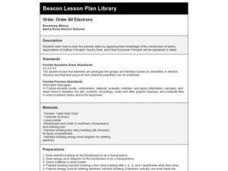Curated OER
Stoichiometry
Balancing equations is a foundational skill for starting chemists. There are a few slides in this PowerPoint with colorful diagrams that help to explain how. Unfortunately, the presentation begins with an unrelated table of contents and...
Curated OER
The Carbon Cycle
Fifth graders examine the carbon cycle, periodic table, and photosynthesis and respiration. They analyze the periodic table and how it is organized, then complete the "Elementary, Dear Watson" worksheet. Students then examine a carbon...
Curated OER
Doing Lewis Dot Diagrams
Students observe the periodic table and draw the Lewis Dot Diagram. In this investigative lesson students construct information on several elements including the Lewis Dot Formation and take a quiz on the information they learned.
Curated OER
Order, Order All Electrons
Students read the periodic table and apply their knowledge of the construction of atoms. They demonstrate reading the electron configuration of an element on the periodic file.
Curated OER
Elements and Compounds
Eighth graders explore the chemical and physical properties of a variety of elements in a lab setting. They organize the data they collect onto a spreadsheet and then choose one element from the periodic table to research. They...
Curated OER
Electronegativity
Young scholars identify the type of bonding between two atoms of elements given their electronegativity values. They study the trend of electronegativity across the periodic table in small groups.
Curated OER
Protons, Neutrons and Electrons
For this chemistry worksheet, students use the periodic table to complete the chart shown, filling in all of the missing information in the blank spaces. They identify and describe various elements found in the periodic table.
Curated OER
Students Get Animated: Make Existing Lessons Move and Motivate Students
Students study the chemical elements in a computer generated cartoon format. In this computer animation and chemistry lesson, students learn how to animate using computer programs. Students use animation to learn about the Periodic Table...
Curated OER
Are You Charged?
Fourth graders study the charges on ions and familiarize themselves with a quick way to remember charges based on location of elements on the periodic table. They complete a worksheet and share their answers with the class.
Curated OER
Isotopes of Pennies
Pupils demonstrate that isotopes of an element have different masses. They illustrate atomic mass and neutrons. The periodic table is examined in length. Display of a collection of atoms is surveyed.
Curated OER
Metals, Non-metals, Metalloids
Students discuss the physical and chemical properties of metals and non-metals. As a group, they classify items as a metal or non-metal. Using the periodic table chart, students discuss the characteristics of each metal. Based upon...
Curated OER
Electron Configurations of Transition Metal Elements
In this elements worksheet, learners review the electron configuration of given elements and then complete the electron diagrams for the transition metal elements. This worksheet has 5 problems to solve.
Curated OER
Atomic Bonding
For this bonding worksheet, students combine the given atoms to make new neutral compounds. This worksheet has 22 problems to solve.
Curated OER
Metals and Non-Metals
In this metals and non-metals learning exercise, students read an explanation of metals and non-metals and then answer three questions for each about conductivity and form.
Curated OER
Getting Animated
Learners create a simple animation illustrating a chemical element in the periodic table. In this chemistry lesson plan, students create a new way to describe elements by using them in an artistic form.
Curated OER
Element Names and Symbols
In this chemistry activity, students use an interactive website to study the names and symbols of elements. They give the names and symbols of 69 common elements.
Curated OER
Why Do Atoms Combine?
In this atom worksheet, students will complete 8 fill in the blank statements based on the different parts of an atom. Then students will explain how the arrangement of electrons in an atom is related to the periodic table.
Curated OER
Element Symbols
In this chemistry worksheet, students find the symbols for 12 elements on the periodic table. They write the symbols on the lines next to the names of the elements to complete a chart.
Royal Society of Chemistry
Alloys
What are alloys, and why do we use them? Through a series of interactive puzzles, scholars examine the components and uses of several common alloys. The accompanying teacher's resources provide support in using the lesson, printable...
Curated OER
Crystals: What Are They and What Holds Them Together
Students are introduced to the characteristics of crystals and what keeps them together. Using the Periodic Table, they examine the various elements and develop a model of an atom. In groups, they place sugar and salt in petri dishes...
Curated OER
Element Word Search
In this elements worksheet, students are given forty elements from the periodic table to find in a word search either vertically, horizontally, backwards or diagonally.
Curated OER
The Interactive Periodic Table of the Elements
Students study the different types of metals. In this investigative lesson students watch a demonstration on the effects of temperature on atoms and take a tour through baone matter.
Curated OER
If I Was a...? Worksheet: Chemical Elements
In this element worksheet, students choose an element from the Periodic Table. Students pretend they are the element and answer the questions.
Virginia Department of Education
Metals, Nonmetals, and Metalloids
How can one easily classify metals, nonmetals, and metalloids? Pupils answer this question as they experiment with unknown substances and perform tests on conductivity, brittleness, and malleability to determine which unknown belongs in...

























